Pierre Girieud was born in Paris on June 17, 1876. Raised in Provence, the self-taught painter left eventually south of France in 1900, once his military service was over and moved near Place du Tertre in Montmartre alongside some of the greatest modern masters, Braque, Kandinsky, Monge, the Emperor, Launay, Villon, Marquet, Manguin, Camoin, De Mathan, Puy and Picasso to name a few.
There, the artist regularly attends the "Lapin Agile", famous café and headquarter of the creative cluster of Montmartre. An important figure among intellectuals and artists, Girieud’s approach to painting is resolutely new. The painter strives to cross boundaries of traditional representation through intense plastic research, participating in the development of Fauvism and Expressionism.
Exhibited at the Berthe Weill Gallery in 1901, many well-known art dealers express a strong interest in his work. However, the artist is more concerned about his artistic freedom and his "avancées picturales" (pictorial discoveries) and does not wish to paint within the art market’s constraints.
Girieud's fauvist palette is clearly visible in his work "Parrot and Oranges" (1902), which announces his affiliation to the movement led by Matisse and Derain. The painter exhibits at the Salon des Independants in 1903 and 1904 and the Salon d'Automne in 1905 and 1907. His expressionist style, characterized by bold colours, encircled by intense black lines, emerges in 1905 and is highly influenced by the discovery of Gauguin's paintings. With the impulse of his friendship with Kandinsky, Girieud is the first French artist to integrate German expressionist principles and to participate in the New Association of Artists of Munich - N.K.V.M. He then acts as an intermediary between French and German artists.
With his friend, the painter Alfred Lombard, Pierre Girieud, feels deeply inspired by the artistic scene in Provence, very often driven by the beauty of the southern light. Together, they organize the Salons de Mai (in 1912 and 1913), the first exhibition of its kind in South of France, bringing together some of the most important figures in Modern Art such as Van Dongen, Bonnard, Marquet or Friesz.
During his trip to Umbria (Italy) in 1906, Girieud expresses a profound fascination for the art of the Primitives in Sienna. In 1912, having been attracted for many years by the technique of the fresco, the painter produces St Pancrace’s chapel’s mural decoration in a new pictorial style: soft colours, soothed lines, and a new classicism influenced by his attraction to the art of the Renaissance and the work of Puvis de Chavannes. In 1913, he exhibits at the very famous "Armory Show" in New York.
During the Great War, Pierre Girieud has to put his painting practice on hold. The loss of some of his closest friends along with the atrocities he witnesses, profoundly mark Pierre Girieud’s life. He subsequently finds refuge in a new lifestyle, living between Paris and Provence. From that moment, Girieud’s plastic research becomes mainly focused on the fresco technique, which he teaches in Cairo.
Pierre Girieud dies on December 26, 1948, at the age of 72, leaving a work that cannot be categorized. Singular in his poetry, borrowed from the Nabis concepts and his symbolist past, Girieud’s paintings’ expressionist force and fauvist palette fervently demonstrate a rich artistic heritage along with an incredibly innovative approach.
The artist declared: "I would like to paint like a fig tree produces figs, it does not care whether there are rotten ones or some eaten by the birds, it fulfils its function as best it can. I would like to be a good fig tree! ".

Happy Birthday Galerie Pentcheff
11 January 2019 - 9 March 2019

BRAFA 2018
27 January 2018 - 4 February 2018

Fauvisme et modernité en Provence
15 February 2014 - 15 March 2014




